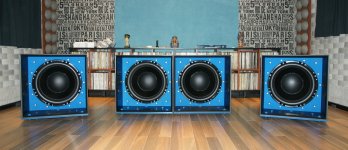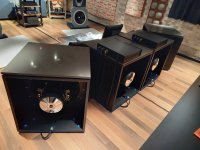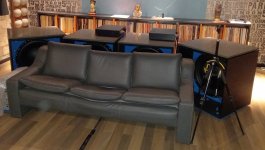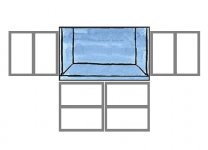Hi all,
I have a possibly quick & probably basic question that I hope one of you may help with: It is how (deep) bass is reproduced with an OB loudspeaker? Would one normally use some kind of EQ (analog or digital filtering) or can a sufficient deep bass level be achieved with "normal means"?
If someone might have a link to an article (or the like) that describes achievable (deep) bass levels with an OB construction vs. maybe "baffle size" I'd appreciate such information.
Cheers & thanks for any insights on this
Jesper
I have a possibly quick & probably basic question that I hope one of you may help with: It is how (deep) bass is reproduced with an OB loudspeaker? Would one normally use some kind of EQ (analog or digital filtering) or can a sufficient deep bass level be achieved with "normal means"?
If someone might have a link to an article (or the like) that describes achievable (deep) bass levels with an OB construction vs. maybe "baffle size" I'd appreciate such information.
Cheers & thanks for any insights on this
Jesper
It's worth mentioning that the required cone excursion in OB increases 8 times for each octave you go below the dipole peak. Two octaves means 8 x 8 = 64 times. However - the bigger the baffle, the more low bass you can achieve.
I managed no more than 105 dB @ 20 Hz with less than 10% THD on my giant H-baffle towers, that had sixteen 21" woofers.... so ... unless you are willing to go completely mad, just forget it.
I managed no more than 105 dB @ 20 Hz with less than 10% THD on my giant H-baffle towers, that had sixteen 21" woofers.... so ... unless you are willing to go completely mad, just forget it.
The easiest way to achieve deep open-baffle bass is by placing the sub(s) very close to the listener's head (within 1.5 ft, though closer is better) - doing that "lifts" the lower-end freq. response (typically) more than enough to compensate for the pressure loss from the rear out-of-phase cancellation of the front in-phase response.
Driver parameters to look for under these (above) conditions are: lots of Sd (larger the driver the better), as low an Fs as possible, and as much linear stroke (excursion) as possible, along with a Qts nearing .5-.6 ..and in general a more efficient driver sound's better than a less efficient driver. IF you need a lower Fs then you can add mass to the dust-cap of the driver to lower Fs some (depending on how compliant the suspension is), or you can just eq. the lowest freq.s.
Just one of these about a foot away from your head (and aimed correctly with phase/delay adjusted for you system) should work well:
http://www.sbaudience.com/index.php/products/subwoofers/bianco-18sw450/
(..though if you need sub 30 Hz you should eq. the low-end.)
The biggest limitation is that it's for only the listener. A side benefit though that it is only for the listener.
Driver parameters to look for under these (above) conditions are: lots of Sd (larger the driver the better), as low an Fs as possible, and as much linear stroke (excursion) as possible, along with a Qts nearing .5-.6 ..and in general a more efficient driver sound's better than a less efficient driver. IF you need a lower Fs then you can add mass to the dust-cap of the driver to lower Fs some (depending on how compliant the suspension is), or you can just eq. the lowest freq.s.
Just one of these about a foot away from your head (and aimed correctly with phase/delay adjusted for you system) should work well:
http://www.sbaudience.com/index.php/products/subwoofers/bianco-18sw450/
(..though if you need sub 30 Hz you should eq. the low-end.)
The biggest limitation is that it's for only the listener. A side benefit though that it is only for the listener.
With a larger baffle and multiple drivers (e.g. two 15s or 18s) you can get some good SPL down to 30Hz. Getting any lower is wishful thinking, but 30Hz is actually pretty low for music type signals. You will never be able to pressurize the room with an OB sub so there is always that little bit lacking compared to well-deployed sealed subs IMHO. That's why I now design my OB systems with a low corner frequency of about 80-100Hz in mind, with sealed subs filling in below that point. 80-100Hz is where the breakpoint of "need a big baffle" starts, so you can keep the OB system smaller visually with this approach.
General info about dipoles
http://www.dipolplus.de/
http://musicanddesign.speakerdesign.net/tech.html
And yes, forget dipoles (OB) below 100Hz!

http://www.dipolplus.de/
http://musicanddesign.speakerdesign.net/tech.html
And yes, forget dipoles (OB) below 100Hz!
Hi all ... & many thanks for your informative & helpful feedbacks  ... Reading your feedbacks I think that you have already given feedback on what I was looking for information about, i.e. the possibility of OB use at low frequencies (and what it overall entails design-wise / EQ-wise) so I actually don't think that I need further replies for now ...
... Reading your feedbacks I think that you have already given feedback on what I was looking for information about, i.e. the possibility of OB use at low frequencies (and what it overall entails design-wise / EQ-wise) so I actually don't think that I need further replies for now ...
Again, many thanks for helping out in this!
Cheers, Jesper
Again, many thanks for helping out in this!
Cheers, Jesper
Agree Scott. Thanks to posts like yours I decided to go for H-Frames in the very near field.The easiest way to achieve deep open-baffle bass is by placing the sub(s) very close to the listener's head (within 1.5 ft, though closer is better) - doing that "lifts" the lower-end freq. response (typically) more than enough to compensate for the pressure loss from the rear out-of-phase cancellation of the front in-phase response.
Driver parameters to look for under these (above) conditions are: lots of Sd (larger the driver the better), as low an Fs as possible, and as much linear stroke (excursion) as possible, along with a Qts nearing .5-.6 ..and in general a more efficient driver sound's better than a less efficient driver. IF you need a lower Fs then you can add mass to the dust-cap of the driver to lower Fs some (depending on how compliant the suspension is), or you can just eq. the lowest freq.s.
Just one of these about a foot away from your head (and aimed correctly with phase/delay adjusted for you system) should work well:
http://www.sbaudience.com/index.php/products/subwoofers/bianco-18sw450/
(..though if you need sub 30 Hz you should eq. the low-end.)
The biggest limitation is that it's for only the listener. A side benefit though that it is only for the listener.
As far as I read it is not necessary to stay as close as 1.5 feet, if you seat within one driver diameter is enough. I once read from Kreskovsky (and from Mr. Laub too) in subs arrangement like this, you are basically listening mostly to the monopole radiation and I would add, without the resonances they have.
This are Stereo Integrity SH24 24" drivers, Qts 0.4, not the ideal 0.5 but close. The rest of the Klippel verified parameters are fine for the application, they are also super silent.
The subs are crossed @ 70Hz (LR4) to a AE Dipole-18 and to match sensitivity all the subs had to be attenuated 20dB (which was great for vinyl). The subs are delayed 5.3mS to the main speakers.
Still having one amp per channel (one amp per each pair of subs), I plan to feed each sub with a single amplifier, this will give additional flexibility in the delay and EQ. However I am not sure this to be necessary. Amps are Hypex UcD 2K. All XO/EQ is done with one Xilica XD4080 per channel.
Of course, both subs in the outer position are not within the near field. I am still tempted to use a smaller sofa and install the external subs as shown in the sketch, but this would be rather extreme, all considered, the bass is gorgeous.
Attachments
I had made simulation of H-frame OB bass and built them.
To get 30+30 cm H-frame playing down to 23 Hz needs about +20dB correction at 23 Hz.
So you need lot of Xmax and sensitive speaker elements but still cannot play them very loud.
https://www.diyaudio.com/community/threads/h-frame-or-w-frame-ob-bass.365074/post-6463420
https://www.diyaudio.com/community/threads/amt-pro-4-as-ob-tweeter.366280/post-6770439
To get 30+30 cm H-frame playing down to 23 Hz needs about +20dB correction at 23 Hz.
So you need lot of Xmax and sensitive speaker elements but still cannot play them very loud.
https://www.diyaudio.com/community/threads/h-frame-or-w-frame-ob-bass.365074/post-6463420
https://www.diyaudio.com/community/threads/amt-pro-4-as-ob-tweeter.366280/post-6770439
My experience and measurements tell me it's close enough if you are within a meter.As far as I read it is not necessary to stay as close as 1.5 feet, if you seat within one driver diameter is enough.
I'm not at all surprised, you ticked all the boxes. Your neighbours would like the system too. Bass in their place will be >20dB lower with your system compared to a conventional sub setup.all considered, the bass is gorgeous.
Well done!
Agree Scott. Thanks to posts like yours I decided to go for H-Frames in the very near field.
As far as I read it is not necessary to stay as close as 1.5 feet, if you seat within one driver diameter is enough. I once read from Kreskovsky (and from Mr. Laub too) in subs arrangement like this, you are basically listening mostly to the monopole radiation and I would add, without the resonances they have.
This are Stereo Integrity SH24 24" drivers, Qts 0.4, not the ideal 0.5 but close. The rest of the Klippel verified parameters are fine for the application, they are also super silent.
The subs are crossed @ 70Hz (LR4) to a AE Dipole-18 and to match sensitivity all the subs had to be attenuated 20dB (which was great for vinyl). The subs are delayed 5.3mS to the main speakers.
Still having one amp per channel (one amp per each pair of subs), I plan to feed each sub with a single amplifier, this will give additional flexibility in the delay and EQ. However I am not sure this to be necessary. Amps are Hypex UcD 2K. All XO/EQ is done with one Xilica XD4080 per channel.
Of course, both subs in the outer position are not within the near field. I am still tempted to use a smaller sofa and install the external subs as shown in the sketch, but this would be rather extreme, all considered, the bass is gorgeous.
One of the nicest systems I've seen on Diyaudio!

Distance depends on several factors, but really - for integration it's just something you measure until you get what you are looking for. (..I always advise closer than further away because it's always going to result in less pressure loss with increased distance (absent a lumped room mode right next to the listener); it's more of a general suggestion so that others aren't disappointed if they start with the sub's further away and don't get the response they are looking for.)
Everyones seems to think it's essential to play loud. And yes, for loud you need to go wild on surface area and Xmax with OB woofers.
I don't play at 100dB. Anything over 85 for more than a few minutes will give you hearing damage anyway. 85 dB is quite substantial, conversation is hardly possible with music playing at such level. A system that will do 90-95 dB is imho more than sufficient for home use.
So just to give an example from the other end of the spectrum: I use only one 12" long stroke woofer per channel, 25mm Xmax, in a modified H frame of about 20" deep. Very small enclosure. Eq'd actively, about 17dB correction @ 25 Hz. That is less than you'd expect to be necessary, but they are placed along a side wall which helps. They run flat to just under 30Hz at listening position, powered from a 70W amp. Crossed over at 100Hz to an esl panel. The system can play at 90-95 dBa with almost all music, but I seldom play that loud. The involvement into the soundstage, realism and reproduction of fine details is such, that I don't feel the need to play any louder.
OB bass misses the kick in the stomach effect, you'll have to get used to it. But once you do, you probably never look back. The lack of coloration and detail is something very special. To me all enclosed systems sound the same now, the dreaded one note bass tone.
I don't play at 100dB. Anything over 85 for more than a few minutes will give you hearing damage anyway. 85 dB is quite substantial, conversation is hardly possible with music playing at such level. A system that will do 90-95 dB is imho more than sufficient for home use.
So just to give an example from the other end of the spectrum: I use only one 12" long stroke woofer per channel, 25mm Xmax, in a modified H frame of about 20" deep. Very small enclosure. Eq'd actively, about 17dB correction @ 25 Hz. That is less than you'd expect to be necessary, but they are placed along a side wall which helps. They run flat to just under 30Hz at listening position, powered from a 70W amp. Crossed over at 100Hz to an esl panel. The system can play at 90-95 dBa with almost all music, but I seldom play that loud. The involvement into the soundstage, realism and reproduction of fine details is such, that I don't feel the need to play any louder.
OB bass misses the kick in the stomach effect, you'll have to get used to it. But once you do, you probably never look back. The lack of coloration and detail is something very special. To me all enclosed systems sound the same now, the dreaded one note bass tone.
Last edited:
as a general comment, Personally I would also like to try this setup very much if it was not for the neighbours. As I live in an apartment I stuck to dipole bass, which does indeed have the advantage that it does leak less to other rooms.With a larger baffle and multiple drivers (e.g. two 15s or 18s) you can get some good SPL down to 30Hz. Getting any lower is wishful thinking, but 30Hz is actually pretty low for music type signals. You will never be able to pressurize the room with an OB sub so there is always that little bit lacking compared to well-deployed sealed subs IMHO. That's why I now design my OB systems with a low corner frequency of about 80-100Hz in mind, with sealed subs filling in below that point. 80-100Hz is where the breakpoint of "need a big baffle" starts, so you can keep the OB system smaller visually with this approach.
Just an FWIW that I managed flat-to-25Hz with a Beyma 15P1200Nd per side. Lots of EQ and large amps needed, and the cone excursion was scary at times. Listening distance was less than 10'.
It's easy to see how the requirements might multiply with larger listening distances etc.
Chris
It's easy to see how the requirements might multiply with larger listening distances etc.
Chris
no bass reflex?I see a trend that OB is used down to say 60 Hz and then people build sealed boxes to cover the rest below. It makes sense - no box sound in upper bass and proper pressure in the sub region... active/dsp is probably necessary...
//
-correction: more pressure loss with increased distance.it's always going to result in less pressure loss with increased distance (absent a lumped room mode right next to the listener)
My fast typing is cr@p!
"Everyone" knows that a sealed, LT EQ'd, bass with Q 0,5 is the sheiit ;-Dno bass reflex?
So, why not BR - because below BR Fo, the bass sees no box anymore... not very good for pressure...
//
- Home
- Loudspeakers
- Multi-Way
- Open baffle (deep) bass reproduction?



